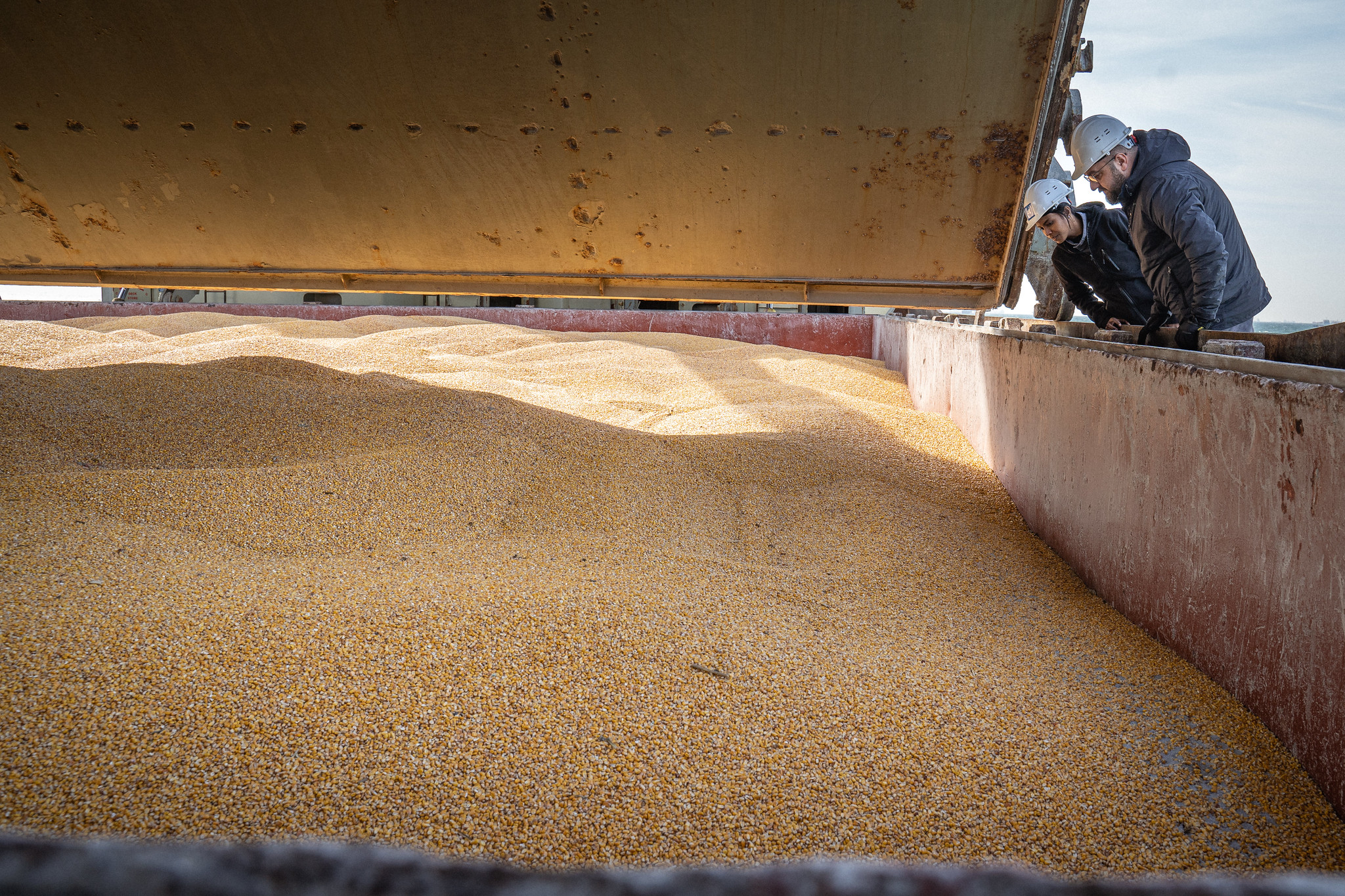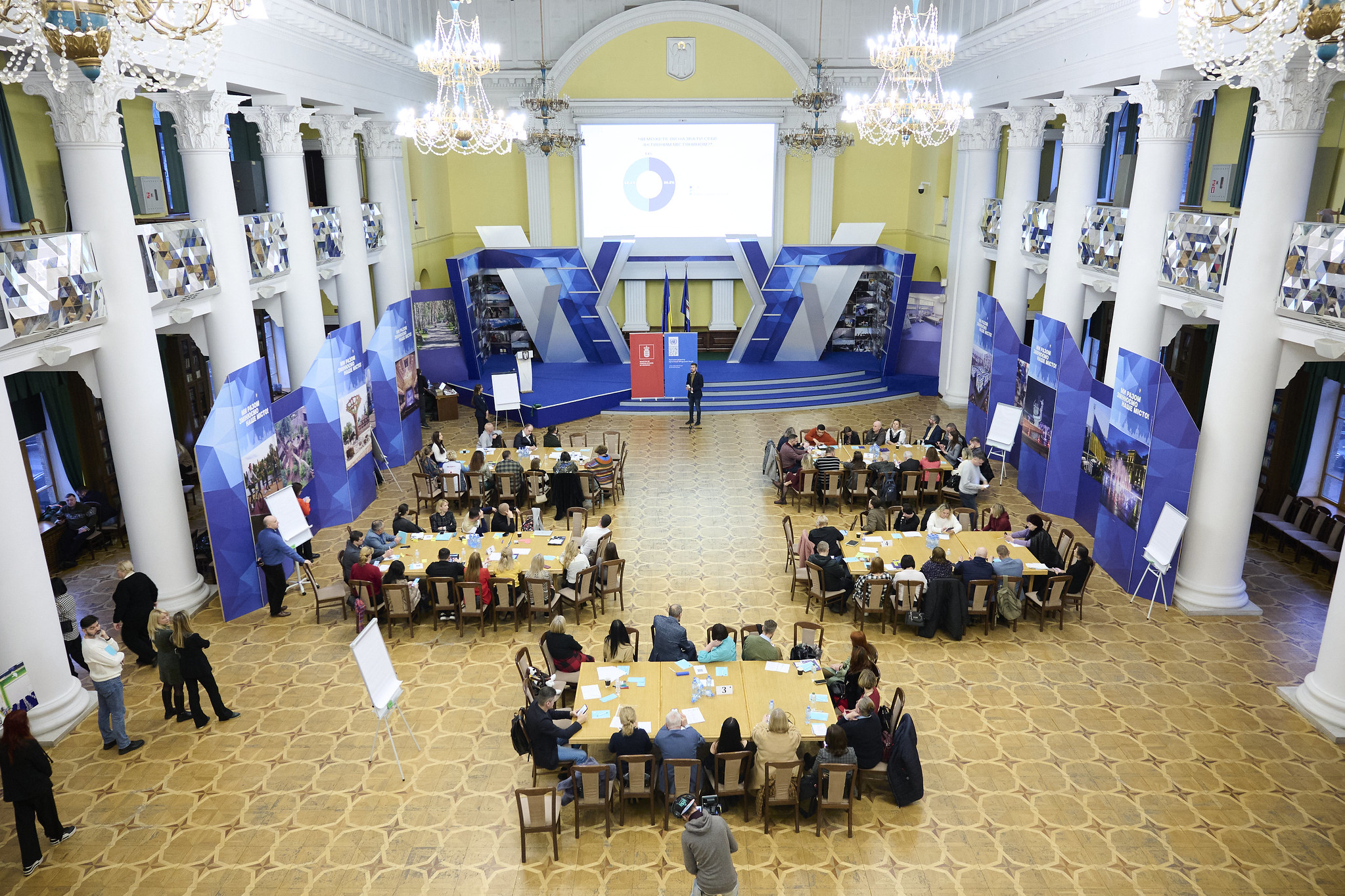Resilience amidst war: Ukraine's road ahead
Russia’s invasion of Ukraine has an enormous impact on the current and future security of Europe. This Clingendael Spectator series analyses how Europe’s relation with Ukraine and Russia will be affected. In the fifth episode, Clingendael expert Julia Soldatiuk-Westerveld reflects on how Ukraine aims to stay resilient in the context of a long war and what the European Union can do to support these efforts.
Despite ongoing international discussions on how to end the war, Ukrainians are not betting on the hostilities with Russia to end soon. Over two years after the large-scale invasion began, and ten years since the start of the war in the Donbas, Ukraine is readying itself for an even longer conflict.
How does Ukraine aim to stay resilient in the context of a long war, and what can the European Union do to support these efforts? This article aims to answer these questions through four different angles: scaling up Ukraine’s defence industry, strengthening Ukraine’s economy, supporting Ukraine’s civil society and joining efforts in strengthening the resilience to Russian information warfare.
Scaling up defensive capabilities
After a period of overwhelming military support for Ukraine and optimism about a counteroffensive, Ukraine is currently back to defensive positions. The country does not have enough ammunition and long-range missiles to protect itself properly from Russia’s military advances, let alone reclaim territory. Simultaneously, the West is struggling to provide Ukraine with what it needs.
Ukraine needs stronger defensive capabilities; not only in the short and medium term, but also in the longer run when the war is over and Ukraine needs to deter Russia from invading again. Examples from Taiwan1 , Israel2 and India3 show that successful deterrence requires strong defensive capabilities.
For this, two things are necessary: security guarantees from an ally in the form of a military alliance, such as NATO or NATO member states, and an upscaling of domestic arms production. As prospects of NATO membership are not progressing so far, Ukraine is focussing its attention on the latter. In 2023, Ukraine initiated significant advancements in its defence industry, aligning with NATO standards and expanding production in various sectors, including artillery systems, ammunition, hybrid air defence equipment, drones and thermal imagers.4
Ukraine needs to look for ways to reduce defence investments as a percentage of GDP
The country has undertaken reforms to involve private companies in its previously state-owned defence complex, with over 190 enterprises now participating. Ukraine has also introduced robotised systems on the battlefield, such as water-surface and underwater drones, which have proven effective against the Russian Black Sea fleet.5 The smaller first-person view (FPV) drones are effectively deployed on land to target Russian vehicles and artillery but cannot compensate for the lack of conventional artillery ammunition. The impact of these drones is therefore limited without a consistent supply of Western artillery. Long-range drones are in the process of development as well to target objects further beyond the frontline.
For the strategy of domestic production to be successful, it is important to ensure that the Ukrainian share of investments in the defence industry does not overly burden its national economy. Currently, Ukraine’s defence budget is estimated to be no less than 21,6% of its GDP for 2024, with over half of the state budget allocated to the security and defence sector.6 This is deemed an unsustainable amount. For reference, NATO members defence spending averages between 2% and 4% of the national GDP, global defence spending in 2023 grew by 9%,7 and Russia’s current defence spending reaches 7,5% of its GDP. Ukraine thus needs to look for ways to reduce defence investments as a percentage of GDP. This would require both a stable economic recovery and the assurance of consistent foreign support for its defence industry.
Ukraine is seeking bilateral military alliances to stimulate foreign investment and closer cooperation with partners to scale up its domestic defence industry. Such agreements have been signed with the UK, France, Germany, the Netherlands, Denmark, Canada, Italy and Finland.8
The countries that signed these agreements commit themselves to at least maintain the current level of support to Ukraine for the next decade.9 They prioritise strengthening Ukrainian defence capabilities through direct military support, investments in research and development and the production of weapons in Ukraine itself.10
Looking ahead, Ukraine aims to prioritise high-tech military systems by using advanced technologies like AI and positioning itself as an attractive partner for the EU in the field of military research and innovation. The EU could facilitate this partnership by fostering technology sharing and innovation. Nevertheless, providing military aid to Ukraine – air defence systems and ammunition, spare parts and other weapon systems, which Ukraine cannot (yet) produce at scale – remains essential to counter the current Russian attacks and further advancement into Ukraine’s territory.
Supporting stable economic recovery
A strong and stable economic recovery is key for upholding Ukraine’s resilience. In the first year of the war, Ukraine experienced a significant 28,8% decline in GDP. However, last year, the country managed a modest recovery, registering an economic growth of 4,6%, as estimated by the International Monetary Fund (IMF) and Ukraine’s Ministry of Economic Affairs.11
Next to partly restored grain exports, much of this growth is owed to foreign budgetary aid, meaning that Ukraine’s economy remains vulnerable due to its reliance on external financial injections.
To reduce the dependence on foreign support, recovery funding needs to be structured in a way that strengthens the fundamentals of the country’s economy. This includes reducing the dependency of Ukrainian companies on imports while increasing their export capacity.
The removal of trade barriers would help achieve the goal of strengthening Ukrainian businesses, particularly in the agricultural sector
The role of small and medium-sized enterprises (SMEs) is of particular importance here, as their empowerment serves as a safeguard against business monopolisation, which could exacerbate inequalities and revitalise oligarchic structures that President Volodymyr Zelensky and his government have tried to break down. Over the past two years, Ukraine’s oligarchs have lost much of their influence on the economy, politics and media.12 Notably, the Ukrainian government has broken the monopoly of the five biggest energy and commodity companies, which are currently undergoing comprehensive reforms.
Dedicated efforts towards the reconstruction of SMEs also offer the potential to foster a more competitive business landscape, laying the foundation for a more resilient economy. One of the most impactful initiatives to support Ukraine’s SMEs is the state credit programme ‘Affordable Loans 5-7-9%’.13 Over the past two years, banks have been reluctant to invest in Ukrainian businesses, and government programmes like this encourage them to provide support through loans, notwithstanding the military risks involved.
The removal of trade barriers would help achieve the goal of strengthening Ukrainian businesses,14 particularly in the agricultural sector, an important part of Ukraine’s economy. Before the war, 98% of Ukrainian agricultural commodities were exported via seaports. Redirecting these exports overland became challenging after the blockade of Ukrainian seaports by the Russian fleet. Although the reopening of the maritime export channel via the port of Odesa was a welcome relief for the Ukrainian economy, many other former shipping routes remain closed due to the occupation of various harbours.

Alternative routes, such as the rail and road ‘solidarity lanes’, along with the use of river barges to transport grain up the Danube river, were helpful for restoring agricultural exports. However, these efforts have been hindered by unilateral restrictions on Ukraine’s agricultural products by EU neighbours.
Poland is one such example, fearing the shipments of Ukrainian grain might harm Polish farmers. Those worries might be allayed,15 as a considerable share of these commodities are destined for markets outside the EU.16 Moreover, these restrictions not only harm the Ukrainian economy but also contribute to a food crisis in other parts of the world. Meanwhile, Poland’s imports of grain from Russia increased by more than 50% in 2023 compared to the year before, while across the EU, Russian grain imports declined from 12% to 6% of the total since the invasion of Ukraine.17 To supress these imports into the EU, in March 2024 the European Commission proposed to raise tariffs on Russian and Belarusian grain products.18 It is expected that these restrictions will have a limited effect on the whole of Russian grain exports, as only around 2% of its shipments are destined for Europe.19
According to the World Bank, 50% of Ukraine’s pre-invasion energy generation capacity – mostly coalfired – is currently destroyed or in Russian possession.20 Ukraine now aims to replace that lost capacity with a decentralised and more resilient ‘green’ energy system along the lines of the EU’s accessing priorities and Green Deal.21
Ukraine must further integrate into the EU single market
To implement these plans, three things are required. Firstly, there is a need for public foreign investments and war insurance mechanisms to attract private investments. So far, the World Bank’s Multilateral Investment Guarantee Agency (MIGA) has provided the equivalent of 215 million dollars in guarantees to Ukraine. Additionally, various individual governments like Japan, the UK, Norway and Belgium have established the Support for Ukraine’s Reconstruction and Economy Trust Fund (SURE TR), providing 73 million dollars in insurance capacity.22
Secondly, as mentioned before, local entrepreneurs and SMEs need access to quick and flexible loans, enabling them to take the lead in stimulating local economic growth and job creation in the short term.
Thirdly, Ukraine must further integrate into the EU single market. Last June, Ukraine joined the EU’s Connecting Europe Facility (CEF), which grants Ukrainian companies and public authorities access to EU funding in sectors of mutual interest like transportation, energy and digital domains. Currently, Ukraine is implementing four priority projects through this programme, aimed at increasing connectivity.23 Integration into the European electricity grid through alignment with ENSTO-E24 has aided Ukraine in managing power grid deficits resulting from intentional Russian shelling of electricity infrastructure.
To enhance the meaningful impact of Ukraine's integration into formal EU structures, in addition to the tools and financing mechanisms provided by the EU, supporting Ukraine's integration into both these formal structures and its informal networks, associations and professional communities would facilitate a mutual understanding of practices and contribute to the ongoing transformation of Ukraine's mindset.
Backing civil society to safeguard Ukraine’s democracy
While the security threat emerging from Russia has mobilised Ukrainian politics and created an incentive to bolster parliamentary scrutiny, parliamentary oversight remains weak. The ongoing Public Administration Reform25
is expected to enhance the parliament’s role in overseeing public institutions. In the meantime, Ukrainian civil society will continue to play an important role in safeguarding the accountability of the government sector, as it has done in the past decade.26

However, following the Russian invasion of Ukraine, many of Ukraine’s civil society organisations were forced to redirect their original focus areas towards humanitarian aid and advocating for military and economic support from other countries. This shift includes human rights organisations and transparency and accountability watchdogs.27
The capacities of these organisations are overstretched, and they struggle to maintain their original objectives. Yet, these objectives remain crucial for holding the government accountable, both during the war and as Ukraine transitions into the postwar period. Until Ukrainian democracy is reinforced, civil society will continue to play a key role in safeguarding 'checks and balances’, thus ensuring that Ukraine's institutions remain on the path of democracy. Hence, the EU could consider ways to provide more capacity and structural funding directly to Ukrainian civil society organisations.
Countering Russian disinformation
The war has played a pivotal role in shaping and solidifying Ukraine's national identity. Russian aggression has fostered a sense of unity among Ukrainians, transcending regional and linguistic differences. Under martial law, the media landscape in Ukraine has experienced a significant shift. Following 24 February 2022, the nine largest media outlets collaborated to create a ‘United News Telemarathon’, aimed at delivering urgent news, fostering cohesion, and deflecting the risks of panic and instability arising from Russian information warfare.
While this is a common measure in a wartime situation, there are ongoing discussions in Ukraine regarding the timing and method of discontinuing the Telemarathon, given its constraints on media freedom. Nevertheless, the participating channels are hesitant to this idea due to financial concerns.28
Information warfare does not stop at the Ukrainian border
Lawmakers in parliament are also hesitant, since the measure has proven very effective in decreasing the impact of Russian disinformation on Ukrainian society, and a viable alternative is yet to be found. Ukraine cannot afford pre-war societal division; it is crucial for the country’s survival to keep the population unified, while simultaneously strengthening a civic Ukrainian identity that also accommodates the country’s rich ethnic and linguistic diversity.
However, information warfare does not stop at the Ukrainian border. At the end of 2023, Russia launched a new disinformation campaign within the European Union, aimed at deepening societal divisions, increasing a feeling of insecurity and lowering support for Ukraine.29 To effectively counter these efforts, it is in the interest of both Ukraine and the EU to cooperate as much as possible on countering Russia’s information warfare efforts.
Between hope and fear
Overall, Ukraine’s resilience rests upon four pillars: its defensive capacities, a robust economy, a strong civil society, and a united and well-informed population. Confronted with Russian aggression, Ukrainians have shown strength and resilience in the past years. Despite, and because of, the war, the country is reforming and progressing towards a European, democratic future.
However, Ukrainians live between hope and fear. Which of the two will be victorious, will be in part determined by the support of other European nations, the United States and Ukraine’s partners around the world. The recent approval of the military and financial support package by the American House of Representatives should not diminish the urgency within the EU to sustain its support to Ukraine. After all, Ukraine’s success remains strategically vital for the European Union, as the EU’s decisiveness and backing of Ukraine’s interests impact its influence and global reputation worldwide.
- 1Wei-chin Lee, Taiwan’s Political Re-Alignment and Diplomatic Challenges, London: Palgrave Macmillam, 2019.
- 2Shmuel Bar, ‘Israeli strategic deterrence doctrine and practice’, Comparative Strategy, vol. 39, ed 4, 2020, pg. 321-353.
- 3Abhijnan Rej, ‘India Is Not Changing Its Policy On No First Use OF Nuclear Weapons’, War On Rocks, 29 March 2017.
- 4‘Ukraine began to produce artillery systems according to NATO standards, doubled the production of ammunition’, Finance.ua, 17 January 2024.
- 5Alex Babenko, ‘Ukraine Minister comments on achievements of defence industry, plans for 2024’, Associated Press, 28 December 2023.
- 6Yuriy Kobzar, ‘Ukraine will spend more than 21% of GDP on defense - presidential decree’, YHIAH, 10 October 2023.
- 7‘The Military Balance 2024 spotlights an era of global insecurity’, IISS, 13 February 2024.
- 8Tom Balmforth and Yuliia Dysa, ‘Explainer: What are the security deals Ukraine is signing with allies?’, Reuters, 3 April 2024.
- 9Wojciech Lorenz, ‘Bilateral Security Agreements with Ukraine Present Opportunities and Challenges’, The Polish Institute of International Affairs, 26 February 2024.
- 10Defence companies such as Rheinmetall from Germany and British Aerospace are planning to build factories in Ukraine. Turkish investors have already started building a factory for the production of Bayraktar drones. The Military Innovation Technology Solutions Program (MITS) Accelerator was recently launched, a joint initiative of Ukrainian and US defence companies that aims at boosting Ukrainian defence tech start-ups.
- 11‘Ukraine's GDP grows by about 5% in 2023 – Svyrydenko’, Ukrinform, 12 January 2024.
- 12Ben Hall, ‘The Crackdown on Ukraine’s Oligarchs’, Financial Times, 29 November 2023.
- 13Yaroslav Zhalilo, ‘The Revival of Bank Crediting in the Wartime Economy of Ukraine’, GLOBSEC, 28 February 2023.
- 14IMF, ‘Staff report for the 2023 article iv consultation, second review under the extended arrangement under the extended fund facility, and requests for modification of performance criteria and a waiver of nonobservance of performance criterion’, 4 December 2023.
- 15In January 2024, the EU agreed to prolong the suspension of import duties and quotas on Ukrainian exports to the EU until June 5, 2025. Protective measures are reinforced to minimise any negative effects on the markets of the individual member states. Poland, Slovakia and Hungary continue to maintain import bans on Ukrainian agricultural goods.
- 16‘5 Myths about the Ukrainian Agriculture’, UCAB, 27 March 2024.
- 17‘How much grain is Poland importing from Ukraine and Russia?’, Notes From Poland, 4 March 2024; Iwona Wiśniewska, ‘An increase in Russia’s agri-food exports’, OSW, 1 March 2024.
- 18Directorate-General for Neighbourhood and Enlargement Negotiations, ‘Commission proposes increased tariffs on Russian and Belarusian grain products’, European Commission, 22 March 2024.
- 19‘EU to impose tariffs on Russian grain imports, sources say’, Reuters, 19 March 2024.
- 20Craig Hart and Talya Vatman, ‘Russia’s attacks on Ukraine’s energy sector have escalated again as winter sets in’, IEA, 17 January 2024.
- 21Besides this, agricultural production in Ukraine itself has declined. Partly because farm workers have been drafted into the Ukrainian army, and partly because some 25% (5 million hectares) of farmland are considered mined or contaminated by explosive remnants. Ukraine’s current recovery priority sectors are housing, energy systems, water supply, and transport infrastructure. Aligned with the EU accession priorities, the Ukrainian government is prioritising the ecological dimension of recovery, by both ensuring that reconstruction efforts adhere to the EU Green Deal and emphasising the environmental damage caused by the war.
- 22Ben Dyson, ‘Big task of restoring war insurance in Ukraine starting with small steps’, S&P Global, 29 February 2024; MIGA, ‘Support to Ukraine’s Reconstruction and Economy Trust Fund (SURE TF)’, MIGA.
- 23European Commission, ‘Commission further integrates Ukraine into EU Single Market through the Connecting Europe Facility for infrastructure funding’, European Commission, 6 June 2023.
- 24ENTSO-E, the European Network of Transmission System Operators, represents 40 electricity transmission system operators (TSOs) from 36 countries across Europe, thus extending beyond EU borders. Also see: Directorate-General for Energy, ‘2 years since Ukraine and Moldova synchronised electricity grids with EU’, European Commission, 15 March 2024.
- 25The Public Administration Reform is a comprehensive reform of the public sector and civil service in Ukraine, launched a few years after the adoption of the Ukraine-EU Association Agreement. This reform is seen as a remedy to transform the public system Ukraine has inherited into accountable and transparent public governance.
- 26Bob Deen and Julia Soldatiuk-Westerveld, ‘Ukraine’s State-civil Partnership to reform the Security Sector’, Clingendael, 27 September 2023.
- 27This shift is partly driven by the occasional failures of international humanitarian organisations to deliver effective and timely responses. For example, after the Kakhovka Dam destruction, Russian shelling deterred international organisations from travelling to the area immediately following the explosion, resulting in emergency relief being delivered almost exclusively by Ukrainian organisations.
- 28Stanislav Pohorilov, ‘Majority of Ukrainians want parliamentary session broadcasts to return’, Ukrainska Pravda, 8 January 2024.
- 29Sydney Freedberg, ‘Brute force: Russia ‘doubled down’ on often-crude disinformation in 2023, says report’, Breaking Defense, 29 February 2024.









0 Reacties
Reactie toevoegen